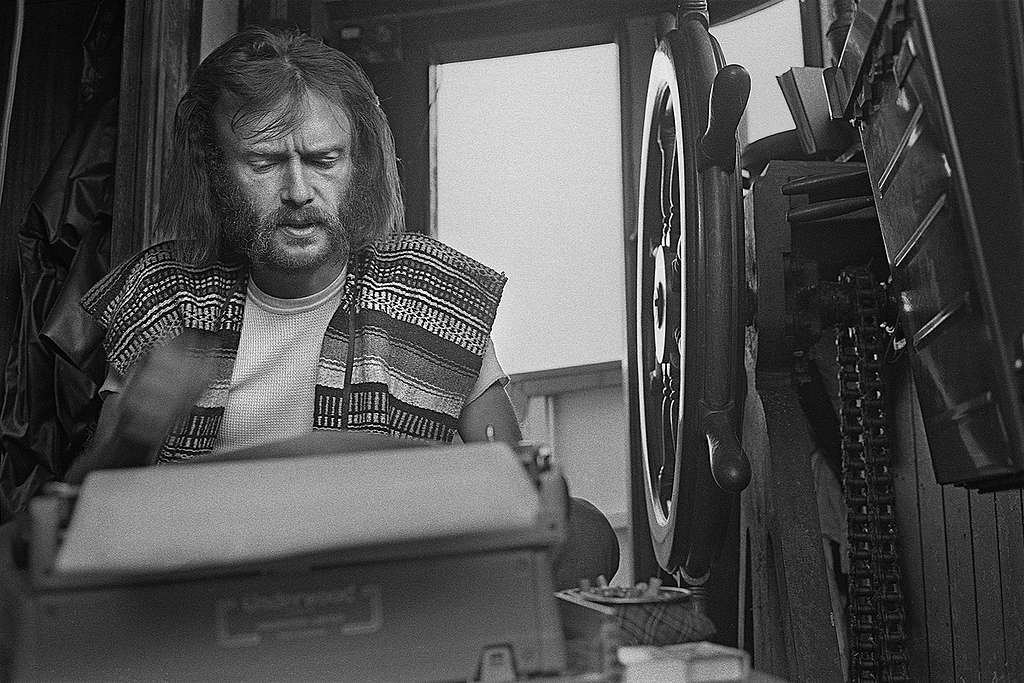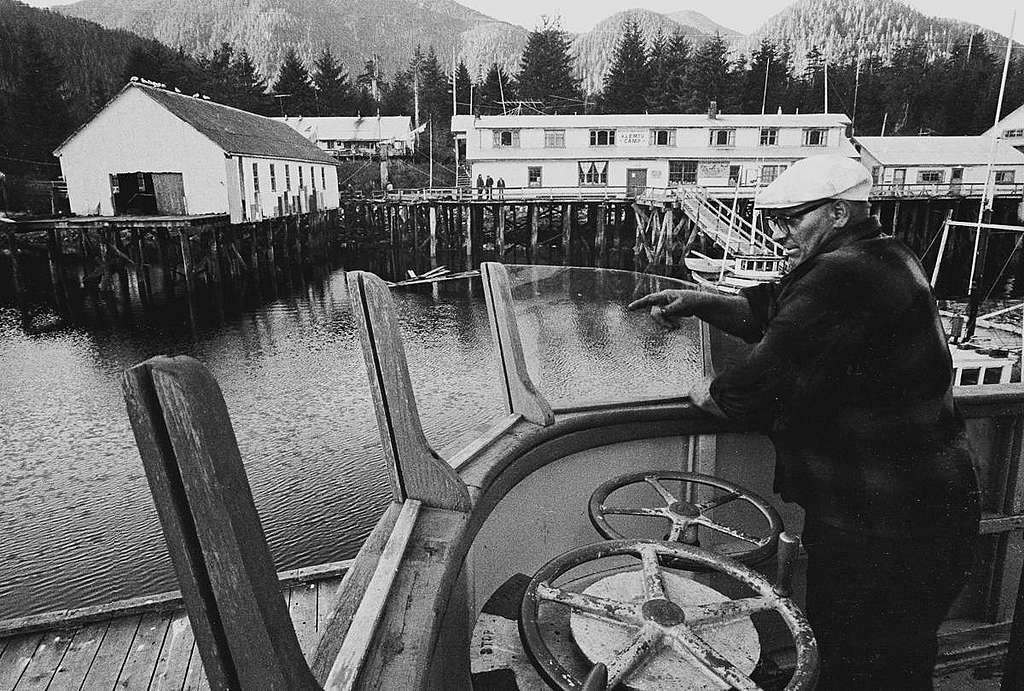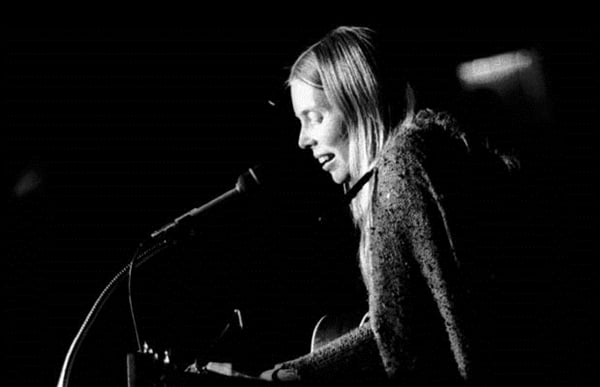This September 2021, Greenpeace will celebrate 50 years of environmental activism, dating from the launch of the first Greenpeace campaign to stop a nuclear bomb test in Alaska.
Leading up to the anniversary, Greenpeace will reflect on — and we will see media coverage about — the early campaigns, and subsequent years of lessons, risks, failures, and successes. Greenpeace, however, did not arise out of thin air. It’s important to consider some of the cultural context, circumstances, and movements that gave rise to Greenpeace in Vancouver, Canada in 1971.
An emerging ecology movement
The global Zeitgeist after World War II resonated with a desire for peace. Even so, the Cold War between Russia and the European/American allies led to dozens of surrogate conflicts — Korea, Vietnam, Palestine, Cuba — and a chilling nuclear arms race.
During the 1950s, common citizens around the world began to hear new words such as “fallout” and “genetic mutation,” and the fear of nuclear holocaust gripped the world. A nuclear disarmament movement started in Japan, in response to the experiences at Hiroshima and Nagasaki, and this movement connected with older pacifist traditions around the world.
In Providence, Rhode Island, in the United States, Irving and Dorothy Strasmich (later “Stowe”) were among millions influenced by the nuclear bomb threats. Dorothy had organized the first social workers union in Rhode Island and became president of the state employees union. Irving was a lawyer and jazz enthusiast, and his Black musician friends invited him to join the National Association for the Advancement of Colored People, the NAACP. Dorothy and Irving married in 1953, with a reception dinner at NAACP headquarters. The couple attended Quaker meetings and later took the name “Stowe” after Harriet Beecher Stowe, Quaker advocate for women’s rights and the abolition of slavery. Two decades later, they would help launch Greenpeace. The Stowes were fighters. “Find out just what people will submit to,” I recall Dorothy quoting abolitionist Frederick Douglass, “and you have found out the exact amount of injustice and wrong that will be imposed upon them.”
Canadian Ben Metcalfe lied about his age to get into the British Air Force during World War II. While he served the British in India, Congress Party leader Mohandas Gandhi refused to cooperate with the British war effort. Metcalfe sympathized with Gandhi’s pacifist movement that made the British look like hypocrites. To avoid bombing pro-Gandhi villages as ordered, Metcalfe and his Hawker Demon bomber pilot dropped their bombs in fallow fields while villagers below watched and waved. The airmen’s defiance was probably an act of treason under British law, but Metcalfe and his pilot supported Gandhi’s views. After the war, Ben became a journalist in Winnipeg, Canada and married colleague journalist Dorothy Harris. The couple moved to Vancouver in 1956 and they both became instrumental in the founding of Greenpeace.
Bob Hunter learned about bombs and radioactive fallout in grade school in Winnipeg. As a teenager, he heard about US Army General James Gavin telling the US Senate that a Soviet nuclear attack could leave vast regions of North America uninhabitable, which inspired him to write a short futurist novel, After the Bomb, about a post-nuclear-holocaust civilization. Hunter quit school in 1958, after grade 11, and set out to be a writer. In London, he met his future wife, Zoe, who introduced him to Bertrand Russell during a nuclear disarmament march in London.
In 1962, at the age of 21, Hunter read Rachel Carson’s Silent Spring and began to think about a new idea: Ecology. He realized that Carson’s statement “in nature, nothing exists alone,” was literally true, and this changed the way he saw the world. Stopping militarism wasn’t enough; we had to stop another war against the natural world.
Meanwhile, a young biologist, Dr. Barry Commoner, had been collecting deciduous teeth from children in St. Louis and documenting the absorption of strontium-90, a carcinogenic byproduct of nuclear explosions. Militarism was now a source of deadly pollution. The peace movement and the ecology movement began to merge.
Look it up!
In 1966, Irving and Dorothy Stowe, in opposition to the US war in Vietnam, moved to Vancouver, on Canada’s west coast, with their two children, Robert and Barbara. They attended Quaker meetings, led peace marches to the US embassy, and corresponded with Bob Hunter, who was now writing for the Vancouver Sun newspaper, and with Ben and Dorothy Metcalfe, who were reporting for the CBC. They worked with Indigenous rights groups and with Deeno Birmingham and Lille d’Easum from Canada’s Voice of Women.
Hunter wrote about ecology, civil rights, and the peace movement in his newspaper column, and worked on his first non-fiction book, The Enemies of Anarchy His book addressed the “consciousness of interrelationships” that he had picked up from Rachel Carson, a cultural revolution that Hunter believed would involve social diversity, gender equality, electronic media, and ecology. He grew convinced that the next big change in society would be an ecological revolution. He told his friends at the pub, “Ecology is the thing.”

Ben and Dorothy Metcalfe uncovered a scheme to swindle B.C.’s Sekani First Nation out of their homeland to construct a hydro-power dam financed by Axel Wennergren, a Swedish industrialist suspected of working with the Nazis. Ben Metcalfe’s story in the Vancouver Province newspaper was picked up by Toronto media, inciting Liberal Cabinet Minister Jack Pickersgill to blurt out, “I’m not interested in sick Indians.” The incident blew up across Canada and Metcalfe became a media celebrity.
In 1969, Ben Metcalfe went fishing in Howe Sound, near Vancouver, and witnessed the stench from bellowing smokestacks at the Port Mellon pulp mill. A few weeks later, he attended a Forestry Commission meeting and asked the politicians what they planned to do about the foul air in Howe Sound. “We have to accept it,” an industry executive told Metcalfe. “No we don’t,” Metcalfe declared. On their own initiative, at a cost of $4,000, the Metcalfes placed twelve billboards around the city. They created a logo to represent the environment, two waves joined together into a spiral maze. “If you can promote companies and products,” he told his friends, “you can promote ideas.” The billboards declared:
Ecology?
Look it up! You’re involved.
An ecology movement was being born in Vancouver.
A Green Peace
I was one of some 50,000 American draft resisters, opposing the Vietnam War, who slipped north into Canada between 1965 and 1973. I soon met the peace activists such as Hunter and the Stowes. Vancouver was an eclectic city. Chinese and Japanese communities flourished, with Buddhist temples, Tibetan meditation centers, Quakers, beat poetry coffeehouses, and a radical network of back-to-the-land farmers, naturalists, and conservationists.
Jim and Marie Bohlen came to Vancouver to avoid the military draft for their sons, Lance and Paul. Jim from New York’s West Bronx had joined the US Navy and, like Metcalfe, had witnessed Japan after the bombings. He met Marie — a nature illustrator, a member of the Sierra Club — at a Quaker gathering in Pennsylvania. In Vancouver, they joined the Sierra Club, met the Stowes, and became close friends.
In the working-class neighborhood of East Vancouver, twenty-two year-old Bill Darnell organized an “Ecology Caravan,” which toured the province. When the government proposed a highway through Vancouver’s beach front, Darnell helped organize protests — with the Stowes, the Hunters, and others — that blockaded bulldozers and halted the project. With this campaign, the environmentalists in Vancouver discovered the greatest inspiration to any social visionary: they could win.
A single event brought all these people together. In November 1969, the United States announced a 5-megaton thermonuclear bomb test, code name “Cannikan,” scheduled for October 1971 on remote Amchitka Island, 4000 kilometers northwest of Vancouver, across the Gulf of Alaska, among the Aleutian Islands. The island was supposedly a US Federal Wildlife Refuge for 131 species of sea birds. An earlier, smaller test, had registered 6.9 on the Richter scale and killed wildlife all around the island. The Cannikin test was going to be five-times more powerful.
Bob Hunter wrote a column about the risks, proposing that the explosion could cause a tsunami that might swamp western Canada. For a demonstration at the US/Canada border, he created a sign, declaring: “DON’T MAKE A WAVE.” At the protest he met Irving Stowe in person, who proposed forming a citizen’s group to halt the bomb. Stowe called Deeno Birmingham with the Voice of Women, Bill Darnell, the Metcalfes, and the Bohlens. Hunter reached out to radical activists Rod Marining and Paul Watson. They formed an ad hoc group, technically a committee of the Sierra Club, that they called “The Don’t Make a Wave Committee.”
The group, however, did not yet have a plan.
Jim and Marie were familiar with a 1958 Quaker protest boat, the Golden Rule, that sailed from California to Enewetak Island nuclear test site in the Philippine Sea. The US Coast Guard intercepted the ship and arrested the captain, Albert Bigalow, but pictures of the ship appeared around the world, stirring the pacifist movements. One morning, over coffee, Marie told her husband, “We should just sail a boat to Alaska.”
That same day, a Vancouver Sun reporter called, asking what the Sierra Club might be planning to stop the test. Caught off guard, Bohlen blurted out, “We hope to sail a boat to Amchitka to confront the bomb.” The Sun ran the story the next day, and suddenly, the Don’t Make a Wave Committee had a plan.
The Committee met at the Unitarian Church to discuss this idea, and ponder how they would find a boat and skipper willing to make the trip. As the meeting ended, Irving Stowe flashed the “V” sign, and said “Peace.” Bill Darnell replied quietly, in the same off-handed manner that Marie Bohlen had suggested the boat, “make it a green peace.”
This term, “green peace” articulated the merging peace and ecology movements, and stuck in everyone’s mind. When Lille d’Easum, the 71-year-old executive of the BC Voice of Women wrote a research paper in March 1970, “Nuclear Testing in the Aleutians,” the Committee published it under the “Greenpeace” banner, the world’s first Greenpeace pamphlet.
Ex-Navy officer Jim Bohlen toured the waterfront, looking for a boat. At the Fraser River docks, he met Captain John Cormack, 60, who owned an 80-foot halibut boat the Phyllis Cormack, named after his wife. Cormack had 40 years experience fishing the west coast. The idea of taking his boat across the treacherous Gulf of Alaska in the fall storm season did not faze him. He agreed to take the charter.

When the Sierra Club rejected the campaign idea, the Don’t Make a Wave Committee proceeded independently, incorporated as a non-profit society, and prepared to launch the 80-foot fish boat, which Captain Cormack agreed could be re-christened for the voyage as “Greenpeace.”
Irving Stowe called his pacifist friend Joan Baez to stage a benefit concert to fund the campaign. Baez could not attend, but introduced Stowe to Joni Mitchell, who agreed, and who brought rising star James Taylor with her. They were joined by pacifist music legend Phil Ochs, and by popular Canadian band Chilliwack. In October, 1970, the event raised $17,000, enough for the boat charter and some basic expenses.

Greenpeace had emerged spontaneously, out of the social stirrings of the 1960s, civil rights, women’s rights, Indigenous rights, workers’ rights, pacifism, and the emerging awareness of ecology. After the first campaign, the Don’t Make A Wave Committee adopted the name that so perfectly articulated a new, emerging zeitgeist: Greenpeace Foundation.
about the author
Rex Weyler
Rex Weyler was a director of the original Greenpeace Foundation, the editor of the organisation's first newsletter, and a co-founder of Greenpeace International in 1979.
Rex's column ... Read More

No comments:
Post a Comment
Note: Only a member of this blog may post a comment.